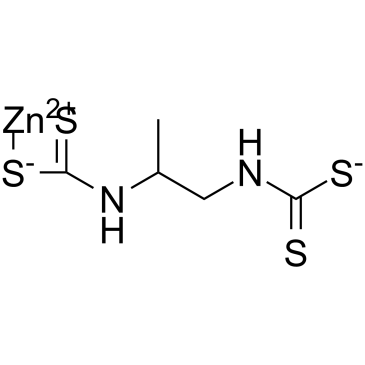propineb

propineb structure
|
Common Name | propineb | ||
|---|---|---|---|---|
| CAS Number | 12071-83-9 | Molecular Weight | 289.77 | |
| Density | N/A | Boiling Point | 315.4ºC at 760 mmHg | |
| Molecular Formula | C5H8N2S4Zn | Melting Point | 160ºC | |
| MSDS | Chinese USA | Flash Point | 144.5ºC | |
|
[Teratogenic and goitrogenic activity of propineb and propylenethiourea in the rat].
Boll. Soc. Ital. Biol. Sper. 61(2) , 271-8, (1985) The teratogenic and goitrogenic effects of Propineb, dithiocarbamate pesticide and Propylenthiourea (PLTU), its metabolite and degradation product have been studied. The aim of this study was to show the possible correlation between the two activities. Female... |
|
|
Dithiocarbamate pesticides: activity of Propineb in the micronucleus test in mice.
Mutat. Res. 135(3) , 193-7, (1984) The possible clastogenic activity of Propineb, Propineb technical grade and of its main metabolite, propylene-thiourea (PLTU), was investigated by the micronucleus test in mice according to Schmid. No statistically significant increase in the percentage of mi... |
|
|
Determination of dithiocarbamate fungicide propineb and its main metabolite propylenethiourea in airborne samples.
Chemosphere 68(11) , 2104-10, (2007) A simple, rapid and sensitive GC-MS method for the determination of dithiocarbamate fungicide propineb [polymeric zinc propylenebis (dithiocarbamate)] and an improved HPLC procedure for the simultaneous determination of its main metabolite, propylenethiourea,... |
|
|
Effects of the dithiocarbamate fungicide propineb in primary neuronal cell cultures and skeletal muscle cells of the rat.
Arch. Toxicol. 76(7) , 414-22, (2002) After repeated-dose toxicity studies with the fungicide propineb, reversible effects on muscle functions were found. Therefore, mechanistic investigations should contribute to clarification of its mode of action in relation to disulfiram and diethyldithiocarb... |
|
|
Effects of some pesticides on the vital organs of juvenile rainbow trout (Oncorhynchus mykiss).
Tissue Cell 42(6) , 376-82, (2010) Gill, trunk kidney, spleen, and liver of rainbow trout (Oncorhynchus mykiss) were examined after exposure to different sublethal concentrations of carbosulfan (25, 50 and 200 μgL(-1)), propineb (3, 6 and 24 mgL(-1)), and benomyl (2, 5 and 20 mgL(-1)) for 14 d... |
|
|
[Determination of 4 dithiocarbamate residues in 22 matrices by gas chromatography].
Se Pu 28(12) , 1162-7, (2010) A gas chromatographic method with flame photometric detection (FPD (sulfur filter)) for analyzing the residues of 4 dithiocarbamates in 22 matrices in a heated closed vial has been established. The dithiocarbamate residues were decomposed to carbon disulfide ... |
|
|
[Toxicologic evaluation of propyneb on the Wistar rat].
J. Toxicol. Clin. Exp. 11(7-8) , 407-16, (1991) This experiment was performed in Wistar rats of both sexes exposed subchronically to 1:100, 1:500, 1:1000 and 1:1500 LD50. The evaluation was based on endpoints measured on the 30th and 90th after starting exposure and after a recovery period of 30 days: thes... |
|
|
Dithiocarbamate propineb induces acetylcholine release through cytoskeletal actin depolymerization in PC12 cells.
Toxicol. Lett. 182(1-3) , 63-8, (2008) Neurological complications as well as movement disorders are relevant symptoms in animals and humans chronically exposed to dithiocarbamates. Using rat pheochromocytoma cells differentiated by NGF (PC12), we investigated whether propineb affects acetylcholine... |
|
|
Development and validation of a cellular biosensor detecting pesticide residues in tomatoes.
Talanta 80(5) , 1799-804, (2010) Two of the most important categories of pesticides used in agricultural practice are organophosphates and dithiocarbamates. Their extensive and inappropriate use has rendered their reliable monitoring at trace levels more and more necessary. This study presen... |
|
|
Contact allergy due to propineb.
Contact Dermatitis 43(5) , 310, (2000)
|